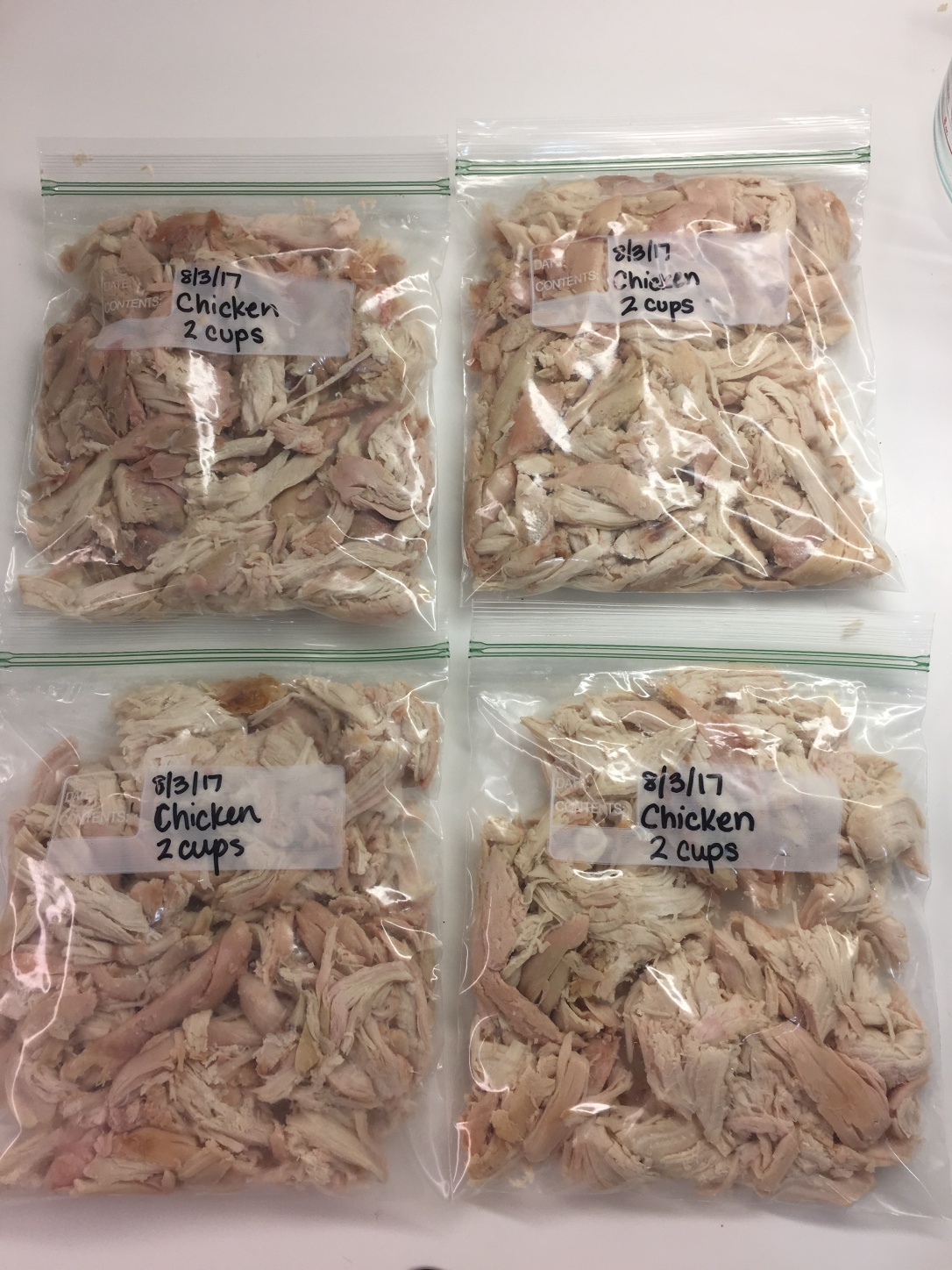Last Updated on November 19, 2023 by Pauline G. Carter
Yes, you can freeze rotisserie chicken for future use. It is a convenient way to store leftovers.
Rotisserie chicken is a popular and convenient option for quick and easy meals. However, it is not always possible to finish the entire bird in one sitting. Freezing rotisserie chicken allows you to extend its shelf life for future consumption.
By freezing the chicken promptly, you can preserve its freshness and flavor. This method is ideal for those who want to minimize food waste and have a ready-to-eat protein option on hand. We will explore the steps to properly freeze rotisserie chicken and some tips for ensuring its taste and texture are not compromised when thawed. So, if you find yourself wondering about freezing rotisserie chicken, read on to learn more.
Preserving Rotisserie Chicken
Rotisserie chicken is a delicious and convenient option for a quick meal. However, it’s not always possible to consume it all in one sitting. Luckily, you can freeze rotisserie chicken to extend its shelf life and enjoy it later. In this article, we will explore the importance of proper storage and common methods of preserving rotisserie chicken.
Importance Of Proper Storage
Proper storage is crucial to maintain the quality and safety of your frozen rotisserie chicken. By following these guidelines, you can ensure that the taste and texture remain as close to freshly cooked as possible:
- Temperature: Store your rotisserie chicken at a temperature of 0°F (-18°C) or below in the freezer.
- Packaging: As soon as you bring the chicken home, remove it from the packaging and transfer it to freezer-safe containers or resealable plastic bags. This helps prevent freezer burn and preserves the flavor.
- Date and labeling: Don’t forget to label your containers or bags with the date of freezing. This allows you to keep track of how long the chicken has been in the freezer.
Common Methods Of Preservation
There are a few common methods you can use to preserve your rotisserie chicken:
- Whole chicken: If you have a whole rotisserie chicken, you can freeze it as it is. However, ensure it is properly wrapped or placed in an airtight container to prevent freezer burn.
- Individual portions: If you prefer portioned servings, you can divide the chicken into smaller pieces before freezing. This allows you to thaw and use only what you need, without having to defrost the entire chicken.
- Shredded chicken: Shredded rotisserie chicken can be easily frozen and used for a variety of recipes like sandwiches, salads, or casseroles. Make sure to separate the shreds and remove any excess moisture before freezing to maintain the texture.
- Chicken broth: Don’t waste the flavorful juices and drippings from the rotisserie chicken! Freeze them in ice cube trays or containers to use as a base for soups, stews, or sauces in the future.
By utilizing these preservation methods and storing your rotisserie chicken appropriately, you can keep it fresh for up to three months in the freezer. This comes in handy when you’re in need of a quick and effortless meal option.
Can You Freeze Rotisserie Chicken?
Rotisserie chicken is a delicious and convenient option for quick and easy meals. But what if you have leftovers or find a great deal on rotisserie chicken and want to stock up? The question arises: can you freeze rotisserie chicken? The good news is, yes, you can freeze rotisserie chicken! Freezing it allows you to extend its shelf life and have it ready for future use. However, there are a few things to consider before freezing.
Benefits Of Freezing
There are several benefits to freezing rotisserie chicken. Let’s explore some of them:
- Prolongs Shelf Life: Freezing rotisserie chicken can help extend its shelf life by preserving its freshness and flavor.
- Convenience: Having frozen rotisserie chicken on hand can be incredibly convenient, especially for busy individuals or families. It eliminates the need for frequent grocery store trips and allows you to quickly whip up a meal.
- Saves Money: Buying rotisserie chicken in bulk when it’s on sale and freezing it is a great way to save money. You can take advantage of discounted prices and enjoy rotisserie chicken at a later time.
- Reduces Food Waste: By freezing your leftover rotisserie chicken, you can avoid wasting food and make use of every part of the bird.
Impact On Flavor And Texture
While freezing rotisserie chicken is a convenient option, it’s important to note that freezing may have an impact on its flavor and texture. Here’s what you need to know:
- Texture Changes: Freezing can affect the texture of rotisserie chicken, making it slightly drier compared to when it’s fresh. However, the extent of texture change may vary depending on the quality of the chicken and the freezing method used.
- Flavor Intensity: Freezing can cause a slight reduction in the overall flavor intensity of rotisserie chicken. However, proper packaging and storage can help minimize flavor loss.
- Recommended Storage Time: For the best results, it is recommended to consume frozen rotisserie chicken within 2-3 months. This ensures that the chicken retains its quality and taste.
Freezing rotisserie chicken is a practical way to extend its shelf life and have it readily available for future meals. While there may be some slight changes in flavor and texture, the convenience and money-saving benefits certainly make it worth considering. Just remember to properly package and label your frozen rotisserie chicken to ensure optimum quality when you’re ready to enjoy it.
Selecting The Right Containers
When it comes to freezing rotisserie chicken, selecting the right containers plays a crucial role in maintaining its flavor and texture. The right containers not only help in preserving the quality of the chicken but also make it convenient for you to store and thaw. Let’s take a look at the different types of freezer-safe containers and wrapping techniques you can use to ensure optimal freshness.
Types Of Freezer-safe Containers
Choosing the right freezer-safe container is important to prevent freezer burn and maintain the taste of your rotisserie chicken. There are a few options available that are suitable for freezing:
Glass Containers
- Glass containers are an excellent choice for freezing rotisserie chicken.
- They are durable, non-toxic, and can withstand extreme temperatures.
- Make sure to use containers with airtight lids to prevent freezer burn.
Plastic Containers
- Plastic containers made explicitly for freezer use are also suitable.
- Look for containers with a tight-sealing lid to keep out air and moisture.
- Ensure that the containers are BPA-free for food safety.
Freezer Bags
- Freezer bags are a versatile option for freezing rotisserie chicken.
- They are space-saving and allow for easy stacking in the freezer.
- Opt for heavy-duty freezer bags that are specifically designed for freezing.
| Type of Container | Advantages |
|---|---|
| Glass Containers | Durable, non-toxic, and airtight |
| Plastic Containers | Tight-sealing, BPA-free |
| Freezer Bags | Space-saving, easy stacking |
Wrapping Techniques For Optimal Freshness
Proper wrapping is key to preserving the taste and texture of your rotisserie chicken. Here are some wrapping techniques to ensure optimal freshness:
- Wrap Individually: Separate the chicken into individual portions before wrapping. This allows you to defrost only what you need without compromising the flavor of the remaining chicken.
- Use Protective Layers: Wrap the chicken tightly in plastic wrap or aluminum foil to protect it from exposure to air and prevent freezer burn.
- Double Bagging: If you choose to use freezer bags, consider double bagging for added protection against freezer burn. Place the wrapped chicken in one bag and then place it inside another bag.
- Label and Date: Don’t forget to label your containers or bags with the date of freezing. This will help you keep track of the freshness of your rotisserie chicken.
By selecting the right containers and using proper wrapping techniques, you can freeze your rotisserie chicken without compromising its flavor or texture. These simple steps ensure that your frozen chicken stays fresh and delicious for future consumption.
Portioning For Convenience
Freezing rotisserie chicken is a convenient way to portion leftovers for future use. This handy method allows you to enjoy the delicious taste of rotisserie chicken whenever you desire, without worrying about food waste.
Dividing Chicken Into Serving Sizes
Portioning rotisserie chicken for convenience is a smart way to make the most out of this delicious meal. By dividing it into serving sizes, you can easily grab just the right amount for a quick lunch, dinner, or snack. Plus, it saves you time and effort in the long run.
When dividing the chicken, you have several options. One way is to separate the chicken into individual portions, typically based on the number of people in your household. For example, if you have four family members, divide the chicken into four equal parts.
| Number of Servings | Chicken Portion |
|---|---|
| 1 | Breast or leg quarter |
| 2 | Half of the chicken |
| 3 | One-third of the chicken |
| 4 | Quarter of the chicken |
If you prefer smaller portions, consider dividing the chicken into individual pieces. This allows you to have the flexibility of using only the desired parts for different recipes. For instance, you can separate the chicken into breasts, wings, drumsticks, and thighs.
No matter which method you choose, ensure that the dividing process is done with clean utensils to maintain food safety. It’s also recommended to wash your hands thoroughly before and after handling the chicken to prevent any cross-contamination.
Labeling With Dates For Tracking Freshness
To keep track of the freshness of your frozen rotisserie chicken portions, labeling with dates is a clever practice. By clearly marking the packaging, you can easily identify the oldest chicken pieces and consume them before moving on to the newer ones.
When labeling, remember to follow the first-in, first-out (FIFO) method. This means that the oldest chicken portions should be used before the newer ones. This ensures that you are always consuming the oldest chicken first, reducing the risk of food waste.
You can use a permanent marker to write the date on the packaging or use adhesive labels if you prefer a more organized approach. Make sure the label is placed in a visible area, such as the front or top of the packaging, for easy reference.
Not only does labeling with dates help you keep track of freshness, but it also allows you to monitor the storage duration of your chicken. This can be especially helpful if you are aiming to use the chicken within a specific timeframe or if you want to keep track of how long it has been in the freezer.
With the convenience of portioning and the help of labeling, freezing rotisserie chicken becomes a breeze. You’ll have delicious and easily accessible portions on hand whenever you need them, while ensuring that you prioritize freshness and food safety in your freezer stash.
Preparing Chicken For Freezing
Rotisserie chicken can be frozen for future use. Simply remove the meat from the bones, pack it tightly in an airtight container, and freeze it for up to three months. Enjoy the convenience of already cooked chicken whenever you need it.
Cooling Down Before Freezing
Before you freeze rotisserie chicken, it’s essential to allow it to cool down properly. This not only ensures the safety of the meat but also helps in maintaining its moisture and flavor. Cooling the chicken properly is a crucial step to prevent bacterial growth and maintain its quality.
To cool down the rotisserie chicken, follow these steps:
- Once you purchase the chicken, remove it from the packaging and place it in a clean and shallow container.
- Allow the chicken to sit at room temperature for about 20-30 minutes. This allows the excess heat to dissipate and prevents condensation when it is placed in the refrigerator.
- After 30 minutes, transfer the chicken to the refrigerator to continue cooling for at least 1-2 hours. This step is crucial to reach the desired temperature for safe refrigeration or freezing.
- Make sure to keep the chicken uncovered while it cools down. This helps in preventing moisture buildup, which can lead to bacterial growth.
Dismantling Versus Whole Freezing
When it comes to freezing rotisserie chicken, you have two options: dismantling it or freezing it whole. Each method has its advantages, and the choice depends on your preference and future usage. Let’s take a closer look at each approach:
Dismantling the chicken
Dismantling the rotisserie chicken involves removing the meat from the bones and separating it into smaller portions. This method offers several benefits:
- Portion control: By dismantling the chicken, you can divide it into individual servings, making it convenient for future meals. This approach is especially useful if you plan on using the chicken for sandwiches, salads, or other recipes that require smaller quantities of meat.
- Easier defrosting: Frozen chicken pieces defrost faster than a whole chicken. This means you can thaw only the amount you need without having to defrost the entire bird.
- Maximizing storage space: Dismantled chicken takes up less space in the freezer compared to a whole chicken. It allows you to organize your freezer efficiently and make room for other frozen items.
Freezing the chicken whole
If you prefer to keep the chicken intact, you can freeze it whole. Here are the advantages of this approach:
- Simpler preparation: Freezing the chicken as a whole requires less time and effort. You can conveniently place the entire chicken in an airtight container or freezer bag and freeze it right away.
- Retaining moisture: When frozen whole, the chicken retains its moisture better, resulting in juicier meat when it’s eventually thawed and cooked.
- Preserving flavors: The whole chicken retains its flavors more effectively during freezing. This is especially beneficial if you plan on reheating and serving it as is.
Consider your cooking preferences, portion requirements, and storage space availability to decide whether to dismantle or freeze the rotisserie chicken whole. Both methods are suitable for freezing, so choose the one that suits your needs best.
The Freezing Process
When you find yourself with leftover rotisserie chicken, freezing it is a great way to make it last longer and always have a convenient protein option on hand. Freezing rotisserie chicken not only preserves its flavors and freshness, but it also saves you time and money in the long run.
Step-by-step Guide To Freezing Chicken
Freezing rotisserie chicken is a simple process that anyone can easily master. By following these step-by-step instructions, you can ensure that your chicken remains delicious and safe to eat even after being frozen.
- Remove the bones and skins: Start by removing the bones and skins from the chicken. This step will help prevent freezer burn and ensure that the chicken freezes evenly.
- Cut the chicken into pieces: If desired, you can cut the chicken into smaller, more manageable pieces. This will make it easier to defrost and use later on.
- Wrap the chicken: Individually wrap each piece of chicken tightly in plastic wrap or place them in airtight freezer bags. This will help eliminate any exposure to air and protect the chicken from freezer burn.
- Label and date: Before placing the chicken in the freezer, be sure to label each package with the date of freezing. This will help you keep track of how long the chicken has been frozen and ensure that you use it within the recommended time frame.
- Store in the freezer: Finally, place the wrapped chicken pieces or bags in the freezer, making sure to arrange them in a way that allows for easy access and efficient space utilization.
How Long To Freeze For Best Quality
For optimal quality, it is recommended to consume your frozen rotisserie chicken within three to four months. While the chicken may still be safe to eat after this time, the flavor and texture may not be as desirable. To maintain the best quality, follow these guidelines:
- Use airtight packaging: Ensure that the chicken is properly wrapped or stored in airtight freezer bags to prevent freezer burn and preserve its flavors.
- Keep a constant temperature: Maintain a steady freezer temperature of 0°F (-18°C) or below. Fluctuating temperatures can negatively impact the quality of the chicken.
- Follow the first-in, first-out rule: To minimize food waste and ensure freshness, organize your freezer with the oldest items at the front. This way, you will use them before the newer ones.
By following these steps and guidelines, you can successfully freeze your rotisserie chicken and enjoy it at a later date while still maintaining its delicious flavors and quality. So, don’t let those leftovers go to waste – freeze them and savor the convenience and versatility they bring to your meals!
Safe Defrosting Methods
Safe defrosting methods for rotisserie chicken ensure that the meat retains its flavor, texture, and quality. Whether you are planning to use the chicken immediately or within a few days, it is essential to follow proper thawing techniques to prevent bacterial growth and maintain food safety. In this article, we will explore two effective methods for thawing rotisserie chicken: refrigerator thawing and water bath thawing.
Refrigerator Thawing
Refrigerator thawing is the safest method for defrosting rotisserie chicken. It is a slow process, but it ensures that the chicken remains at a safe temperature throughout the thawing process. Here is how you can thaw your rotisserie chicken in the refrigerator:
- Remove the rotisserie chicken from its original packaging and place it in a shallow airtight container or zip-top bag.
- Place the container or bag on the bottom shelf of the refrigerator.
- Allow the chicken to thaw for 24 to 48 hours, depending on the size.
- Once thawed, ensure the chicken is thoroughly cooked before consuming.
Refrigerator thawing gives the chicken enough time to defrost gradually while keeping it at a safe temperature below 40°F (4°C). This method helps maintain the chicken’s quality and reduces the risk of bacterial growth. However, if you need to use the chicken quickly and don’t have enough time for refrigerator thawing, consider water bath thawing.
Water Bath Thawing
Water bath thawing is a quicker alternative to refrigerator thawing, but it requires careful attention to temperature and packaging. Follow these steps to safely thaw rotisserie chicken using a water bath:
- Ensure the rotisserie chicken is tightly sealed in a leak-proof plastic bag to prevent water from entering.
- Fill a large bowl or sink with cold water. Make sure the water is not warm or hot.
- Submerge the chicken in the water bath, making sure it is fully submerged.
- Change the water every 30 minutes to maintain a cold temperature. You can also continuously run a thin stream of cold water into the sink.
- Thaw the chicken for approximately 30 minutes per pound.
- Once thawed, cook the chicken immediately to ensure food safety.
Water bath thawing can significantly reduce the thawing time compared to refrigerator thawing. However, it is crucial to monitor the water temperature to prevent the chicken from entering the danger zone, where bacteria can multiply rapidly. By following these safe defrosting methods, you can enjoy the convenience of freezing rotisserie chicken and still savor its delicious flavors in your meals.
Maintaining Quality And Taste
One of the challenges many people face when it comes to enjoying delicious rotisserie chicken is figuring out how to preserve its quality and taste. Luckily, you can freeze rotisserie chicken with great success! By following a few simple tips, you can ensure that your frozen chicken stays just as tasty as the day you bought it.
Tips To Prevent Freezer Burn
Freezer burn is a common issue that can negatively affect the taste and texture of frozen foods, including rotisserie chicken. It occurs when moisture in the food evaporates and then refreezes, causing the surface to become dry and develop unappetizing ice crystals.
To prevent freezer burn and maintain the quality of your frozen rotisserie chicken, consider the following:
- Wrap it tightly: Use plastic wrap or aluminum foil to tightly seal your chicken, ensuring that no air can get in. This will help minimize the exposure to oxygen, reducing the risk of freezer burn.
- Use airtight containers: If you prefer to use containers, make sure they are airtight to prevent air from seeping in and causing freezer burn.
- Date and label: Always label your frozen chicken with the date of freezing. This will help you keep track of how long it has been stored and ensure that you use it before it passes its peak quality.
- Store it in the coldest part: Place your wrapped or containerized chicken in the coldest part of the freezer, usually near the back. The colder the temperature, the slower the moisture loss and the lower the chances of freezer burn.
- Keep it away from strong odors: Rotisserie chicken can absorb odors from other foods in the freezer, so it’s best to store it away from strong-smelling items like onions or garlic.
How Freezing Affects Rotisserie Chicken
When you freeze rotisserie chicken, you may wonder how it affects its taste and quality. The freezing process itself does not significantly alter the nutritional value or taste of the chicken, but it can impact its texture slightly.
Freezing may cause the chicken to become slightly drier upon thawing. However, this can easily be mitigated by reheating the chicken properly. Whether you choose to microwave, bake, or grill it, make sure to add some moisture during the reheating process, such as a drizzle of olive oil or a splash of chicken broth.
In summary, freezing rotisserie chicken is an excellent way to extend its shelf life without compromising its taste and quality. By following the tips mentioned above, you can prevent freezer burn and preserve the deliciousness of your leftover chicken for future meals.
Usage Ideas Post-thaw
Rotisserie chicken is a convenient and delicious choice for a quick meal. It’s easy to freeze the leftover chicken for later use, but what can you do with it once it’s thawed? In this section, we’ll explore some exciting recipe suggestions for thawed chicken and tips to refresh its flavor post-freeze.
Recipe Suggestions For Thawed Chicken
If you have some thawed rotisserie chicken on hand, here are some tasty recipe ideas to help you create a satisfying meal:
- Chicken Salad: Chop the thawed chicken into bite-sized pieces and mix it with some mayo, chopped celery, grapes, and slivered almonds. Serve it on a bed of fresh lettuce or as a filling in a sandwich.
- Chicken Tacos: Shred the chicken and warm it up with some taco seasoning. Fill soft tortillas with the seasoned chicken, along with your favorite toppings like shredded cheese, salsa, and guacamole.
- Chicken Stir-Fry: Slice the thawed chicken and stir-fry it with your favorite vegetables and some soy sauce. Serve it over steamed rice for a quick and vibrant dinner.
- Chicken Pizza: Use the thawed chicken as a topping for your homemade pizza. Spread some tomato sauce on a pizza crust, sprinkle shredded cheese, and add the chicken along with your preferred vegetables.
Refreshing Chicken’s Flavor Post-freeze
After freezing, the flavor of rotisserie chicken may not be as vibrant as when it was freshly cooked. However, there are ways to refresh its taste:
- Marinate Overnight: Place the thawed chicken in a marinade of your choice, such as lemon juice, garlic, and herbs. Let it marinate in the fridge overnight to infuse the chicken with delicious flavors before cooking or consuming it.
- Season and Sear: If you plan to reheat the chicken, season it with your preferred spices and herbs. Then, sear it briefly in a hot pan to enhance its aroma and bring back some of its original juiciness.
- Combine with Flavorful Sauces: Toss the thawed chicken in a flavorful sauce such as teriyaki, barbecue, or buffalo sauce. The sauce will add a burst of taste and moistness to the chicken.
By following these simple recipe suggestions and flavor-refreshing tips, you can transform your thawed rotisserie chicken into a delightful and satisfying meal for you and your family.

Credit: hotmesshousewifeblog.wordpress.com
Monitoring Frozen Chicken
When it comes to freezing rotisserie chicken, it is crucial to monitor your frozen poultry to ensure its quality and safety. Proper monitoring can help you identify any signs of spoilage and maintain recommended storage timelines. In this article, we will discuss the signs of spoilage to watch out for and the recommended storage timelines for freezing rotisserie chicken.
Signs Of Spoilage
It is important to be aware of the signs that indicate frozen rotisserie chicken has spoiled. By regularly monitoring your frozen poultry, you can avoid consuming chicken that may have gone bad. Here are a few signs to look for:
- Unpleasant odor: If your frozen chicken emits a foul smell or a rancid odor, it is a clear indication that it has spoiled. Trust your sense of smell and discard the chicken if it smells off.
- Changes in texture and color: Frozen rotisserie chicken that has spoiled may have noticeable changes in texture, such as excessive freezer burn or a slimy film. Additionally, the color of the chicken may appear dull or different from its usual appearance.
- Unusual taste: If you thaw and cook your frozen chicken, but it has an unusual or off taste, it may indicate spoilage. Trust your taste buds and refrain from consuming chicken with an unpleasant taste.
- Mold growth: Mold growth is a clear indication that your frozen chicken has spoiled. If you notice any visible mold on the chicken, it is best to discard it immediately.
Recommended Storage Timelines
Monitoring the storage timelines of frozen rotisserie chicken is essential to maintain its quality and prevent the risk of foodborne illnesses. Here are the recommended storage timelines:
| Storage Type | Storage Time |
|---|---|
| Freezer bag or airtight container | Up to 4 months |
| Vacuum-sealed packaging | Up to 6 months |
It is worth noting that while frozen rotisserie chicken can be safe to eat beyond these timelines, its quality may deteriorate over time. It is always best to consume the chicken within the recommended storage periods to ensure optimal taste and texture.
By monitoring your frozen rotisserie chicken for signs of spoilage and adhering to the recommended storage timelines, you can enjoy the convenience of frozen chicken while ensuring its safety and quality.
Frequently Asked Questions On Can You Freeze Rotisserie Chicken?
Can You Freeze Rotisserie Chicken?
Yes, you can freeze rotisserie chicken. Freezing is a great way to extend its shelf life and have it for later use.
How Long Can You Freeze Rotisserie Chicken?
You can freeze rotisserie chicken for up to 3 months. Make sure to properly wrap it tightly to prevent freezer burn.
Can You Freeze Whole Rotisserie Chicken?
Absolutely! You can freeze whole rotisserie chicken, but it’s recommended to carve it into smaller pieces for easier storage.
How Do You Freeze Rotisserie Chicken?
To freeze rotisserie chicken, first, let it cool down, then carve it into smaller pieces, wrap them tightly in foil or freezer bags, and place them in the freezer.
How Do You Thaw Frozen Rotisserie Chicken?
To thaw frozen rotisserie chicken, place it in the refrigerator overnight, or use the defrost setting on your microwave for quicker thawing.
Can You Refreeze Thawed Rotisserie Chicken?
It’s not recommended to refreeze thawed rotisserie chicken as it may affect its quality and taste.
Conclusion
Freezing rotisserie chicken is a convenient way to preserve its flavor and make it last longer. By properly packaging and labeling the chicken, you can ensure its quality remains intact. Whether you plan on using the chicken for future meals or as a quick snack, freezing it is a viable option.
So go ahead and stock up on rotisserie chicken without worrying about it going to waste!
About Author (Pauline G. Carter)

Pauline G. Carter is a well-known pet blogger who has written about the world of pets for several years. She is passionate about pets, from cats and dogs to birds, reptiles, and poultry. Her blog, which is updated regularly, is filled with articles and guides on pet care, nutrition, and training. She also shares her experiences and observations on pet ownership, making her blog relatable and informative for pet lovers. She is a true animal advocate and is dedicated to promoting responsible pet ownership. Let’s Go …




